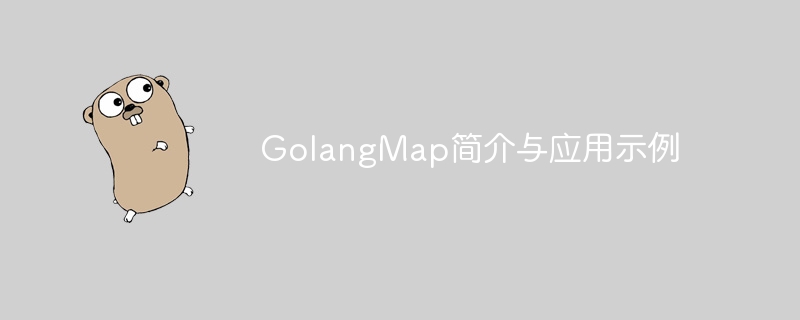
GolangMap简介与应用示例
Golang是Google开发的一种编程语言,被广泛应用于Web开发、云计算、嵌入式系统等领域。其中,Map是Golang中的一种数据结构,用来存储键值对。本文将介绍GolangMap的基本用法及其在实际应用中的示例。
GolangMap的基本用法
Golang的Map是一个无序的键值对集合,其中的键和值可以是任意类型。Map的声明和初始化方式如下:
立即学习“go语言免费学习笔记(深入)”;
//声明一个Map var map1 map[string]int //初始化Map map1 = make(map[string]int) //或者声明并初始化Map map2 := make(map[string]int)
其中,第一个例子是声明了一个未初始化的Map,第二个例子是声明并初始化了一个Map,可以根据需要选择使用。在Map中添加键值对可以使用以下方式:
//添加键值对 map1["one"] = 1 map1["two"] = 2 map1["three"] = 3
在Map中访问某个键对应的值可以使用以下方式:
//访问键对应的值 value := map1["one"]
如果访问一个不存在的键,会返回该类型的零值。如果需要判断该键是否存在,可以使用如下方式:
//判断键是否存在
value, ok := map1["four"]
if ok {
fmt.Println("the value of four is", value)
} else {
fmt.Println("four does not exist in the map")
}其中,第二个返回值为bool类型,表示该键是否存在。
GolangMap的应用示例
在实际应用中,GolangMap可以用来解决很多问题,下面将介绍几个实例。
假设我们现在需要统计一篇文章中每个单词出现的次数,我们可以使用Map来实现:
package main
import (
"fmt"
"strings"
)
func main() {
text := "A happy family is but an earlier heaven."
words := strings.Fields(text)
wordCount := make(map[string]int)
for _, word := range words {
wordCount[word]++
}
for word, count := range wordCount {
fmt.Printf("%s:%d ", word, count)
}
}其中,strings.Fields(text)可以将text分割成单词列表,然后遍历单词列表,统计每个单词出现的次数,最后输出每个单词及其出现的次数。
假设我们需要实现一个缓存系统,可以将一些对象存储在内存中,来提高程序的性能。我们可以使用Map来实现:
package main
import (
"fmt"
"sync"
"time"
)
type Cache struct {
sync.RWMutex
data map[string]interface{}
}
func NewCache() *Cache {
return &Cache{data: make(map[string]interface{})}
}
func (c *Cache) Get(key string) (interface{}, bool) {
c.RLock()
defer c.RUnlock()
val, ok := c.data[key]
return val, ok
}
func (c *Cache) Set(key string, value interface{}) {
c.Lock()
defer c.Unlock()
c.data[key] = value
}
func main() {
cache := NewCache()
cache.Set("key1", "value1")
cache.Set("key2", "value2")
fmt.Println(cache.Get("key1"))
fmt.Println(cache.Get("key2"))
time.Sleep(time.Second * 2)
fmt.Println(cache.Get("key1"))
cache.Set("key2", "new value2")
fmt.Println(cache.Get("key2"))
}其中,NewCache()函数用来初始化一个空的Cache对象,Get()函数用来获取某个键对应的值,Set()函数用来添加或修改某个键对应的值。在main()函数中,我们首先添加了两个键值对,然后输出它们的值,然后等待2秒后再次输出其中一个键的值,可以看到缓存并没有失效,然后修改了一个键对应的值,最后输出该键的值。
假设我们需要实现一个消息队列,可以将一些消息存储在内存中,来实现异步处理。我们可以使用Map来实现:
package main
import (
"fmt"
"sync"
)
type MessageQueue struct {
sync.Mutex
data map[int]string
index int
}
func NewMessageQueue() *MessageQueue {
return &MessageQueue{data: make(map[int]string)}
}
func (mq *MessageQueue) Enqueue(msg string) {
mq.Lock()
defer mq.Unlock()
mq.index++
mq.data[mq.index] = msg
}
func (mq *MessageQueue) Dequeue() string {
mq.Lock()
defer mq.Unlock()
msg, ok := mq.data[1]
if !ok {
return ""
}
delete(mq.data, 1)
for i := 2; i <= mq.index; i++ {
mq.data[i-1] = mq.data[i]
}
mq.index--
return msg
}
func main() {
mq := NewMessageQueue()
mq.Enqueue("hello")
mq.Enqueue("world")
mq.Enqueue("golang")
fmt.Println(mq.Dequeue())
fmt.Println(mq.Dequeue())
fmt.Println(mq.Dequeue())
fmt.Println(mq.Dequeue())
}其中,NewMessageQueue()函数用来初始化一个空的MessageQueue对象,Enqueue()函数用来向消息队列中添加一条消息,Dequeue()函数用来获取消息队列中的一条消息。在main()函数中,我们首先向消息队列中添加了3条消息,然后依次输出它们,最后输出一个不存在的消息。
总结
GolangMap是Golang中的一种数据结构,可以用来存储键值对。在实际应用中,可以使用GolangMap来解决很多实际问题,如统计单词出现的次数、实现缓存、实现消息队列等。本文介绍了GolangMap的基本使用方式及几个实际应用的示例,希望能对Golang的学习者有所帮助。
以上就是了解和应用示例的GolangMap的详细内容,更多请关注php中文网其它相关文章!

每个人都需要一台速度更快、更稳定的 PC。随着时间的推移,垃圾文件、旧注册表数据和不必要的后台进程会占用资源并降低性能。幸运的是,许多工具可以让 Windows 保持平稳运行。

Copyright 2014-2025 https://www.php.cn/ All Rights Reserved | php.cn | 湘ICP备2023035733号